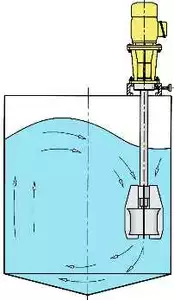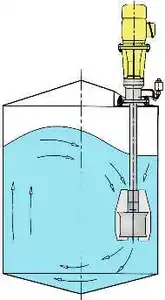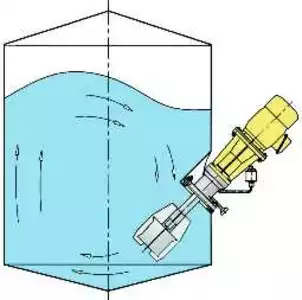YTRON-Y Jet mixer
In process engineering, mixing refers to the combination of substances in a single or multi-phase system. The aim is to compensate for or significantly reduce differences in concentration and/or temperature. If this condition persists, the mixing process is also called homogenization. Commonly referred to as stirrers, these devices allow liquids of different viscosity levels to be mixed. There are different versions, which is why the selection depends on the desired direction of flow, the viscosity range and the task at hand.
The YTRON-Y jet mixer is suitable for a variety of tasks, including homogenization. This is due to the conversion of the movement from radial flow into axial flow. The contents of the container are mixed homogeneously and air-free in a matter of seconds due to the vertical jet. Sedimentation is prevented. The design is individual in order to achieve optimal results for the respective task.
YTRON-Y jet mixer vs. conventional agitators
In contrast to the YTRON-Y jet mixer, conventional agitators are not suitable for all homogenization tasks. Their direction of flow is not exclusively axial, but radially outward, which leads to the formation of two ring vortices. However, there is only limited mass transfer between these ring vortices.
Another advantage over conventional agitators is that the strong axial jet of the YTRON-Y jet mixer avoids sedimentation and vortex formation. A funnel-shaped liquid surface, which is created by the liquid rotating in the container, is called a vortex. Vortex formation leads to increased air intake, which usually has a negative effect on the product quality and the mixing process.
Comparison of the most important features
| YTRON-Y Jet mixer | Conventional agitator | |
| Flow | exclusively axial | radial (rotational flow) |
| Mixing | homogeneous | defective, unhomogeneous |
| Sedimentation | is prevented | unavoidable |
| Vortex formation, air intake | not present | present, aeration (as a consequence: oxidation, colour change, heat transfer problems, etc.) |
| Floating (powder floating) | not present | available |
| Circulation of the entire contents of the container | yes, quickly and intensively | no, incomplete |
| Baffles | No baffles required in the tank, flow baffles integrated in the stator | Flow dead-zones at the baffles in the tank |
| Process time | short, gentle on the product due to the short residence time in the Y mixing head, low shear force input | long, local shear forces |
YTRON-Y jet mixer - installation options
The YTRON-Y jet mixer can be installed in different ways depending on the shape of the mixing container or tank. The vertical installation in the mixing tank is usually eccentric. Liquids are mixed homogeneously in a matter of seconds and without air being sucked in. Side entry installation below product level enables their use in tanks up to 10 m high. A support bearing in the immersion part is not required here either.



YTRON-Y in different versions
The YTRON-Y jet mixer is versatile and universally applicable. There are five different modular sizes and hundreds of possible combinations. With an output of 0.25 kW (laboratory devices) to 55 kW, we offer a wide range for every application. Depending on the application, other individual versions that deviate from the standard are also possible. For safe operation in explosive atmospheres, all sizes are also available in ATEX execution.
YTRON-Y in tank flange design (V11)
This variant (version 11) offers all the advantages of our standard jet mixer. It meets the highest hygiene requirements. All parts that come into contact with the product are easily accessible and therefore easy to clean. The innovative design makes this variant our best jet mixer for a wide range of applications.
Further advantages at a glance:
- Suitable for side entry installation in the process vessel
- Space-saving installation possible due to the short design
- Sealing via cartridge seal (seal optionally replaceable without dismantling the mixer)
- Service-friendly design
- Suitable for homogeneous mixing of thin to viscous liquids

![[Translate to English:] Ytron-Y Leitstrahlmischer Aufsatz](/fileadmin/_processed_/1/8/csm_Ytron-Y_Leitstrahlmischer_373bcb3a61.webp)






![[Translate to English:] YTRON-Y Leitstrahlmischer als Laborgerät](/fileadmin/_processed_/6/b/csm_Y-Labor-S13-neu_3ada516486.webp)

![[Translate to English:] Ytron-Y Leitstrahlmischer Version 11 in Tankflansch-Bauweise](/fileadmin/_processed_/c/d/csm_Ytron-Y_Leitstrahlmischer_in_Tankflansch-Bauweise__Version_11__ee3c00b12a.webp)